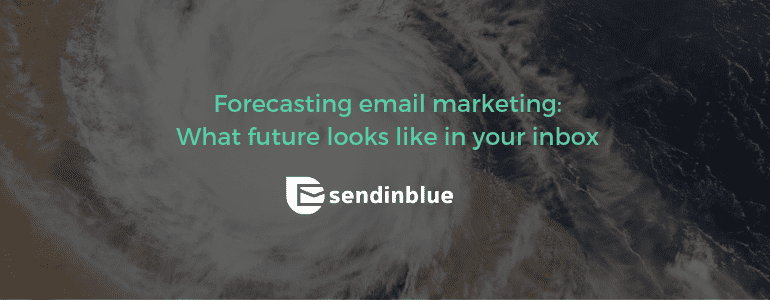
Email has held a highly debated and controversial position in the world of marketing for many years now. We’ve all heard the dramatic claims that ‘email marketing is dead’ and ‘it’s impossible to reach customers in their inbox.’
We can’t say that these claims are all that surprising. Fierce competition, changing consumer behaviour, and last year’s crackdown on data-collection all pose major challenges when it comes to communicating with prospects and customers.
But despite the tech obituary’s repeated attempts to kill off email marketing, it continues to rise.
In 2018, the number of email users worldwide climbed to 3.8 billion. This is expected to grow to over 4.2 billion by the end of 2022. The latest findings from Salesforce also revealed that email is a leading channel when it comes to generating engagement and returns across the entire customer journey.
So while email marketing certainly isn’t dead, no one can deny that it is changing.
Stricter privacy regulations, rapid tech advancements, and heightened consumer expectations are causing email marketing to evolve at a rate that’s faster than ever. Businesses who want to succeed must choose to evolve with it and stay one step ahead.
To help you to achieve this, we’re taking a look at what the future will look like in your inbox.
(If you’re new to email marketing and want to go over the basics first, then have a read of our article on how email marketing works!)
Here are the trends you can’t afford to ignore:
Consumers will have more control
Customer privacy will continue to hold it’s position as the defining issue of the digital era, where customer trust is essential for success.
Last year 4 simple letters wreaked havoc for businesses across the globe. Years of data collection was suddenly sitting precariously on thin ice and databases of contacts started to shrink before our eyes.
The GDPR called for a massive overhaul when it came to data collection and the claims that ‘email is dead’ seemed more real than ever.
But while GDPR and the upcoming ePrivacy regulation are intimidating, they’re far from a death sentence, especially for email marketers who value quality user experience.
There’s no denying that businesses need to work harder for the data. Consent is non-negotiable for any activities handling data as transparency becomes a bigger part of the lead capture landscape moving forward. Trust is earned, so business who want to get ahead need to focus on building authentic customer relationships.
Truly gaining a competitive advantage involves a mindset shift, beyond basic compliance. This means rethinking your entire email marketing process and truly putting your customer’s interests and needs first.
This is where segmentation is key.
As the trend of advanced segmentation grows and the need for more and more contact lists will force many email marketing providers to rethink their policy. Providers like MailChimp and Aweber who charge for every new contact list will need to reassess their pricing models to allow their customers to progress.
More and more businesses are coming to the realization that it’s futile to blast emails to those who don’t want to receive them. They only add to the number of spam reports and unsubscribes they get from the email database. By organizing your email contact list into smaller, more focused lists, you can craft more relevant content based on the interests and behaviors of each segment.
While many businesses feel reluctant to hand over control to customers, those who embrace the movement towards transparency and see it as an opportunity to create more targeted and relevant messaging will likely see a boost in engagement levels and conversions.
With ePrivacy regulation due to come into place in 2019 set to make more changes, businesses need to be proactive and prepare for an era in which data protection and customer privacy must be championed by organizations.
Mass campaigns will be a thing of the past
While we’ve established that email marketing is far from dead, the death toll for ‘bulk email’ is certainly rising.
The era of mass campaigns is well and truly over and is being fast replaced by with personalised, data-enriched email campaigns.
One of the biggest trends we’re seeing in email marketing is a move away from large quantities of emails and content and a drive towards quality and personalisation.
More and more brands are recognising the value of a one-to-one customer journey with more relevant content and appropriate timing. In fact, 80% of customers now say the experience a company provides is as important as its products and services.
Business who see the uniqueness of the customer as an opportunity, instead of a burden, will lead the charge when it comes to successful email campaigns. This means finding a way to sharpen segmentation, relevance, and deliverability – at scale – if you want to keep your customers on side.
The answer?
Marketing automation is one of the fastest growing tools in terms of adoption among digital marketers because of its ability to scale important one-to-one communications and marketing tasks without any technical skills. It allows you to build scalable and repeatable workflows where your most manual and tedious tasks are automated.
Thanks to the emergence of solutions tailored to smaller teams (and budgets) the entry barrier for marketing automation is lower than ever, so we’re going to see a lot more businesses getting savvy with their email marketing.
Advanced automation tactics like lead scoring and dynamic segmentation will soon become the norm for businesses of all sizes, allowing brands to target leads and contacts with more granularity than ever. One-to-many marketing tactics will be a thing of the past as companies get more sophisticated when it comes to mapping customer behaviour patterns.
We’ll hear less and less about B2B or B2C as more businesses focus on H2H – human to human marketing.
Maintaining personalised, individual conversations is essential to guide your contacts through the customer lifecycle and foster long-lasting loyalty. This approach is focused on long-term objectives like retention and increasing the customer lifetime value, rather than short term pay off.
Of course, this is a trend that extends far beyond the realm of email. Across all channels, transactional marketing will evolve toward relationship marketing.
Omni-channel will rise with email at the helm
Which brings us onto our next trend – an omni-channel approach for an integrated customer experience.
Omni-channel marketing is a multi-channel approach that seamlessly integrates the different channels used to communicate with prospects and customers. By uniting the strengths of each channel and using data to understand customer interests and behaviour, omni-channel marketing can deliver a more consistent brand message and optimised customer experience.
Many businesses make the mistake of always chasing the latest shiny object – one month it’s Instagram, next it’s SMS.
Putting all your marketing dollars into one channel won’t cut it anymore. Cross-channel deployment is fast becoming the new normal and businesses need to find a way to link all their customer touchpoints to create a cohesive experience.
Instead of thinking of a social media experience and an email experience, a mobile experience and a desktop experience, businesses need to pursue a more holistic experience that customers can use wherever and whenever they want.
So while email should no longer be considered a standalone channel, it should be central to a winning omni-channel strategy.
It all comes down to our digital ID – the email address.
Your email address is used to log in to accounts, register for courses, subscribe to blogs and podcasts, download apps, and make online purchases.
This digital ID is the core of who we are and how we behave on the internet. It’s our unique online identifier.
Businesses who want to get ahead need to consider the question: how can I use email as the foundation of my omni-channel strategy to create an effortless experience for my customers?
The first step to achieve this is to use your database of email addresses to build rich, data-driven customer profiles. Only then can you begin to integrate email with your other marketing channels.
To successfully implement an omni-channel approach, you need to understand your customer’s digital footprint – everything from where they spend time online, what they are purchasing, and where they are most likely to spend time and money in the future.
With the ongoing explosion of new channels and platforms and a growing number of data, the need to have one place to house all data becomes increasingly necessary. Email marketing services in the future will likely include CRM features as well as links to other marketing channels.
The de-siloing of email marketing is a hugely important trend.
Personalised customer communication needs to be centered on all touch points, not only to attract the attention of customers, but also engage them with meaningful interactions that lead to conversions.
Trust, personalisation, and an effortless customer experience lie at the heart of the future of email marketing.
This means truly understanding your customers and leveraging data to take personalization to the next level. The biggest challenge and opportunity businesses will continue to face when it comes to email marketing is relevancy.
But with the help of marketing automation and an integrated omni-channel approach, customer behaviour mapping will continue to grow in sophistication.
While technology is central to optimising the customer journey, taking a human to human approach is integral to building trust. All great relationships take work. Marketers need to remain in charge of their strategy to create a truly meaningful experience for customers, and allow the technology to bring it to life.
Looking to get more out of your email marketing efforts? Read our article 7 Email Marketing Best Practices to Succeed in 2019.






